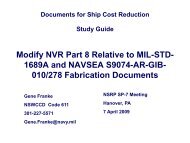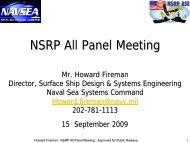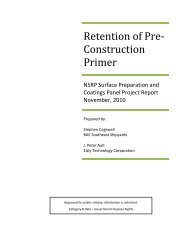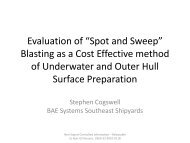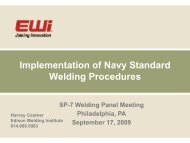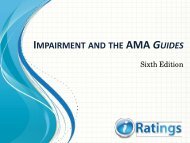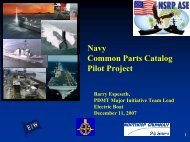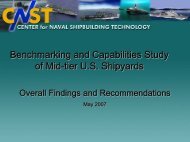Noran Engineering, Inc. FEA Process for Composite ... - NSRP
Noran Engineering, Inc. FEA Process for Composite ... - NSRP
Noran Engineering, Inc. FEA Process for Composite ... - NSRP
Create successful ePaper yourself
Turn your PDF publications into a flip-book with our unique Google optimized e-Paper software.
NEiNastran<br />
Finite Element Analysis of<br />
<strong>Composite</strong>s<br />
Tony Abbey<br />
Technical Manager<br />
tony.abbey@noraneng.com<br />
<strong>Noran</strong> <strong>Engineering</strong>, <strong>Inc</strong>.<br />
<strong>Composite</strong>s May 2006 1
Some <strong>Composite</strong>s-Focused Customers<br />
<strong>Noran</strong> <strong>Engineering</strong>, <strong>Inc</strong>.<br />
<strong>Composite</strong>s May 2006 2
Material Definitions<br />
ISOTROPIC - the same material<br />
properties in all directions, steel is a<br />
typical example.<br />
ANISOTROPIC - different material properties<br />
in all directions, a chunk of volcanic rock is<br />
an example.<br />
ORTHOTROPIC – special case of anisotropic ,<br />
clear material directionality in 3 directions –<br />
represents a carbon fiber/resin matrix <strong>for</strong><br />
example, where the along axis, transverse<br />
axis and through thickness axis are different.<br />
<strong>Noran</strong> <strong>Engineering</strong>, <strong>Inc</strong>.<br />
<strong>Composite</strong>s May 2006 3
Material Definitions<br />
2D ORTHOTROPIC, A further simplification is<br />
where we ignore the through thickness<br />
variation. This is the usual starting point <strong>for</strong><br />
what we call Classical laminate Theory, the<br />
foundation of most FE solutions.<br />
<strong>Noran</strong> <strong>Engineering</strong>, <strong>Inc</strong>.<br />
<strong>Composite</strong>s May 2006 4
Material Behaviour<br />
Single Ply<br />
<strong>Noran</strong> <strong>Engineering</strong>, <strong>Inc</strong>.<br />
<strong>Composite</strong>s May 2006 5
Material Behaviour<br />
<strong>Noran</strong> <strong>Engineering</strong>, <strong>Inc</strong>.<br />
<strong>Composite</strong>s May 2006 6
0 degrees<br />
Material Behaviour<br />
full allowable axial stress is obtained, 154,000 psi<br />
fibers are carrying the load in the most favorable, axial direction.<br />
resin is acting to stabilize the fibers, and not carrying any significant<br />
load.<br />
transverse stress that will tend to pull the fibers apart is zero<br />
shear stress is zero<br />
90 degrees<br />
transverse properties of the material resisting the load.<br />
transverse tension allowable is only 4,500 PSI , based mainly on resin<br />
strength.<br />
0 -> degrees<br />
even a few degrees from zero strength drops off rapidly.<br />
At 10 degrees the stress at failure is down to just over 40,000 psi<br />
fibers are now subjected to transverse stresses,<br />
fibers and the resin have to balance the applied stress state.<br />
weaker transverse strength of the resin reduces the strength.<br />
longitudinal, transverse and shear stresses present<br />
A failure theory analogous to Von Mises stresses <strong>for</strong> Isotropic<br />
materials is used to predict failure.<br />
<strong>Noran</strong> <strong>Engineering</strong>, <strong>Inc</strong>.<br />
<strong>Composite</strong>s May 2006 7
Failure Theories<br />
Tsai-Wu typical model<br />
Xt tension limit, along fiber<br />
Xc compression limit, along fiber<br />
Yt tension limit, transverse fiber<br />
Yc compression limit, transverse fiber<br />
S shear limit<br />
F12 interaction term<br />
Failure Index > 1.0 is bad news<br />
<strong>Noran</strong> <strong>Engineering</strong>, <strong>Inc</strong>.<br />
<strong>Composite</strong>s May 2006 8
Available Failure Theories<br />
Dávila, C.G., Jaunky, N., and Goswami, S., Failure<br />
Criteria <strong>for</strong> FRP Laminates in Plane Stress,<br />
, 2003<br />
Unidirectional materials<br />
in a general state of<br />
plane stress with<br />
unequal tensile and<br />
compressive strengths<br />
Puck<br />
A. Puck and H. Schürmann: “Failure analysis of<br />
FRP laminates by means of physically based<br />
phenomenological models”, 1998<br />
Unidirectional materials<br />
in a general state of<br />
plane stress with<br />
unequal tensile and<br />
compressive strengths<br />
<strong>Noran</strong> <strong>Engineering</strong>, <strong>Inc</strong>.<br />
<strong>Composite</strong>s May 2006 9
Advanced Failure Criteria <strong>for</strong> <strong>Composite</strong>s<br />
<br />
Puck PCP Set of Criteria<br />
• Officially recommended by VDI<br />
• First-ply-failure<br />
• Phenomenological / Physically<br />
based<br />
• Action plane approach<br />
• Failure mode taken into account<br />
• Extensive validation (WWFE)<br />
• Very accurate is material<br />
characterization is available<br />
Compressive strength [MPa]<br />
1200<br />
1000<br />
800<br />
600<br />
400<br />
200<br />
Compressive Strength of [+/-Θ]s Laminates<br />
Test Strength NEiNastran LaRC02 Tsai-Wu Puck<br />
0<br />
0 10 20 30 40 50 60 70 80 90<br />
<strong>Noran</strong> <strong>Engineering</strong>, <strong>Inc</strong>.<br />
Lamination angle Θ [°]<br />
<strong>Composite</strong>s May 2006 10
Ply Layups<br />
<br />
<br />
Single Ply directions exposes weakness<br />
Ply layups used of multiple orientation<br />
Shorthand 0/45/-45/90<br />
<br />
Tuning the layup orientation, thickness and<br />
stacking order is key to optimum design<br />
<strong>Noran</strong> <strong>Engineering</strong>, <strong>Inc</strong>.<br />
<strong>Composite</strong>s May 2006 11
Ply Layups<br />
10000<br />
total load to failure<br />
25000<br />
stress vs ply angle<br />
sig 1<br />
sig 2<br />
9000<br />
20000<br />
sig 12<br />
shear allowable<br />
8000<br />
Y2 allowable<br />
7000<br />
15000<br />
6000<br />
10000<br />
Load (lbf)<br />
5000<br />
4000<br />
Stress Psi<br />
5000<br />
s<br />
3000<br />
0<br />
0 20 40 60 80 100<br />
2000<br />
-5000<br />
1000<br />
-10000<br />
0<br />
0 20 40 60 80 100<br />
Angle(degrees)<br />
-15000<br />
ply angle ( degrees)<br />
Previous Single Ply replaced by 0/90/-45/45/45/-45/90/0<br />
<br />
<br />
Maximum Strength is reduced, but now very predictable<br />
No Optimization! Sometimes called ‘black’ isotropic<br />
material ….<br />
<strong>Noran</strong> <strong>Engineering</strong>, <strong>Inc</strong>.<br />
<strong>Composite</strong>s May 2006 12
Ply Layups<br />
<br />
why 0/90/-45/45/45/-45/90/0 choice?<br />
<strong>Noran</strong> <strong>Engineering</strong>, <strong>Inc</strong>.<br />
<strong>Composite</strong>s May 2006 13
Advanced Failure Criteria <strong>for</strong><br />
Sandwich Structures<br />
<strong>Noran</strong> <strong>Engineering</strong>, <strong>Inc</strong>.<br />
<strong>Composite</strong>s May 2006 14
<strong>FEA</strong> <strong>Process</strong> <strong>for</strong> <strong>Composite</strong> Structure Analysis<br />
Some modelling strategies:<br />
Global Model<br />
Thin shell 2d orthotropic elements model lay-ups and/or honeycomb<br />
face skins and core<br />
Solid isotropic model honeycomb core<br />
Solid 3D orthotropic elements model thick or tapering layups,<br />
orthotropic cores<br />
<br />
<br />
Local Model<br />
<br />
<br />
2D plane strain orthotropic elements<br />
Solid 3D orthotropic elements – ply by ply<br />
<strong>Noran</strong> <strong>Engineering</strong>, <strong>Inc</strong>.<br />
<strong>Composite</strong>s May 2006 15
<strong>FEA</strong> <strong>Process</strong> <strong>for</strong> <strong>Composite</strong> Structure Analysis<br />
<br />
Create or Load 2D orthotropic and/or 3D Orthotropic materials<br />
<strong>Noran</strong> <strong>Engineering</strong>, <strong>Inc</strong>.<br />
<strong>Composite</strong>s May 2006 16
<strong>FEA</strong> <strong>Process</strong> <strong>for</strong> <strong>Composite</strong> Structure Analysis<br />
<br />
Choose regions of common orientation and stackup<br />
<strong>Noran</strong> <strong>Engineering</strong>, <strong>Inc</strong>.<br />
<strong>Composite</strong>s May 2006 17
<strong>FEA</strong> <strong>Process</strong> <strong>for</strong> <strong>Composite</strong> Structure Analysis<br />
<br />
Create schedule of stackups<br />
<strong>Noran</strong> <strong>Engineering</strong>, <strong>Inc</strong>.<br />
<strong>Composite</strong>s May 2006 18
<strong>FEA</strong> <strong>Process</strong> <strong>for</strong> <strong>Composite</strong> Structure Analysis<br />
<br />
Map datum ply orientations<br />
<strong>Noran</strong> <strong>Engineering</strong>, <strong>Inc</strong>.<br />
<strong>Composite</strong>s May 2006 19
<strong>FEA</strong> <strong>Process</strong> <strong>for</strong> <strong>Composite</strong> Structure Analysis<br />
<br />
Account <strong>for</strong> Outer/Inner Mold Line continuity<br />
<strong>Noran</strong> <strong>Engineering</strong>, <strong>Inc</strong>.<br />
<strong>Composite</strong>s May 2006 20
<strong>FEA</strong> <strong>Process</strong> <strong>for</strong> <strong>Composite</strong> Structure Analysis<br />
<br />
Identify regions where F.I. shows failure in the layup<br />
<strong>Noran</strong> <strong>Engineering</strong>, <strong>Inc</strong>.<br />
<strong>Composite</strong>s May 2006 21
<strong>FEA</strong> <strong>Process</strong> <strong>for</strong> <strong>Composite</strong> Structure Analysis<br />
<br />
Identify which plies are failing in the layup in that region<br />
<strong>Noran</strong> <strong>Engineering</strong>, <strong>Inc</strong>.<br />
<strong>Composite</strong>s May 2006 22
<strong>FEA</strong> <strong>Process</strong> <strong>for</strong> <strong>Composite</strong> Structure Analysis<br />
<br />
<br />
<br />
<br />
Review Direct X, Direct Y and Shear XY ply stresses in the<br />
individual ply<br />
Assess major mode of failure<br />
Assess coupling through plies<br />
Redesign if required<br />
<strong>Noran</strong> <strong>Engineering</strong>, <strong>Inc</strong>.<br />
<strong>Composite</strong>s May 2006 23
<strong>FEA</strong> Analysis of <strong>Composite</strong> Structures<br />
Final Thoughts<br />
<br />
<br />
<br />
<br />
<br />
Actual material strength and stiffnesses are subject to many<br />
factors<br />
Fatigue, environmental degradation or abuse loads may dominate<br />
Published data – or generic test data, can only be a guide<br />
‘As Built’ versus ‘As Designed’ in <strong>Composite</strong>s can be significant<br />
<strong>FEA</strong> is not exact<br />
Conclusions<br />
<br />
<br />
<br />
<br />
Aim <strong>for</strong> robust design ( maximum xx microstrains everywhere)<br />
Keep engineering judgment in the picture<br />
Ignore progressive failure and fancy theories in initial design<br />
margins<br />
Test, analyze, ‘correlate’, etc. but test should be the final decider<br />
<strong>Noran</strong> <strong>Engineering</strong>, <strong>Inc</strong>.<br />
<strong>Composite</strong>s May 2006 24





